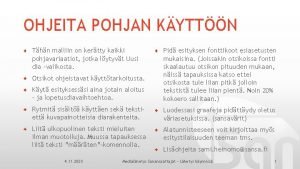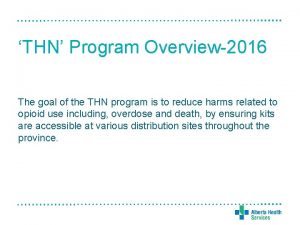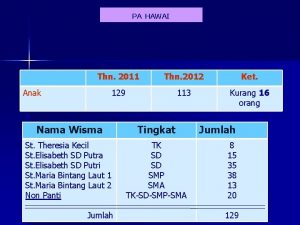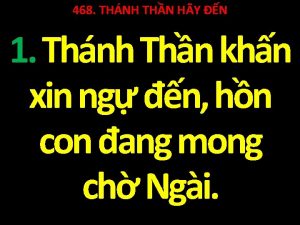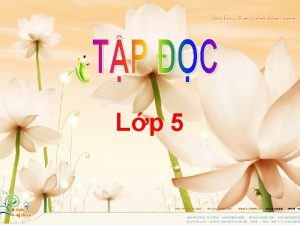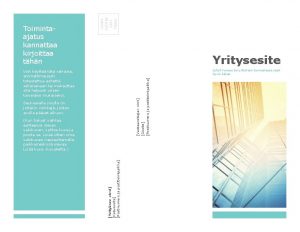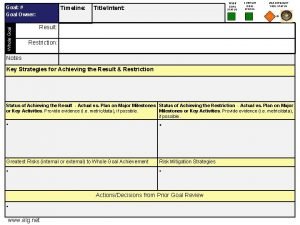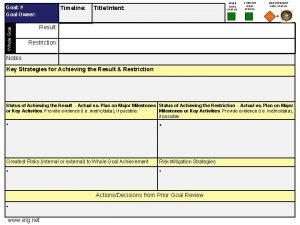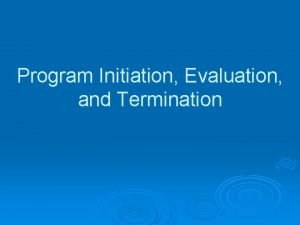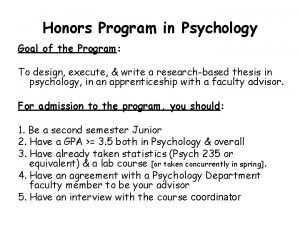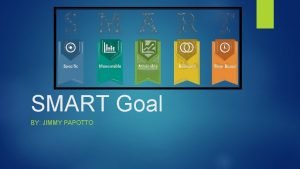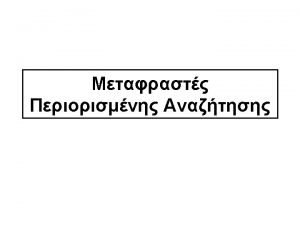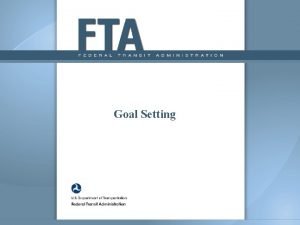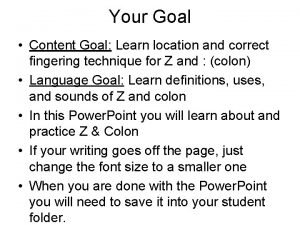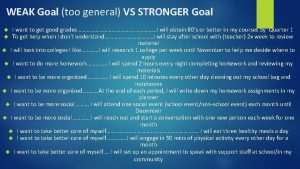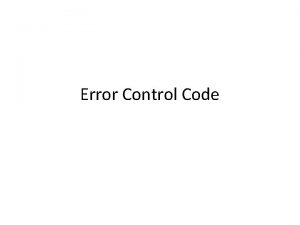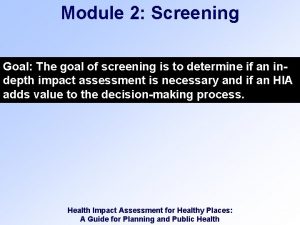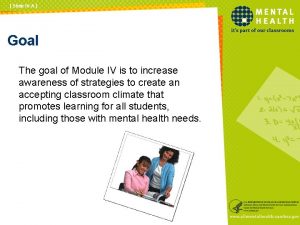THN Program Overview2016 The goal of the THN




































- Slides: 36

‘THN’ Program Overview-2016 The goal of the THN program is to reduce harms related to opioid use including, overdose and death, by ensuring kits are accessible at various distribution sites throughout the province.

Community Based Naloxone (CBN) Project Mission-2018 To ensure anyone who is at risk of witnessing an opioid overdose obtains naloxone through an accessible compassionate and non-stigmatized interaction, and will understand how to correctly respond to an opioid overdose; including notification of emergency services, rescue breathing, and provision of naloxone.

CBN Program Overview Objectives • To provide access to CBN kits and training for Albertans through a wide distribution network. • To facilitate collaboration among stakeholders. • To build capacity through resources and supports to registered sites. • To provide education and training to registered sites. • To increase public awareness of naloxone kit availability and use.

CBN Program Overview • • • Administration Operations Alberta Health HRSC HPSP Legal Professional Colleges • Procurement • Distribution • Education and training • Policy • Communications • Surveillance • Evaluation Partners • ACCH • Non-pharmacy sites • Pharmacies • MFR • FNIHB

CBN Program Overview Overdose Response Kit Distribution As of March 31, 2018 • Cumulative Totals: 54, 157 • Number of Reported Reversals: 3, 607 • Number of Providers/Sites: 1501

Distribution Sites O'Chiese Health Centre Bighorn Health Centre Dr. Thomas Murray Tsuut’ina Health Centre Fort Mc. Murray PH for Gregoire Lake Reserve Levern Clinic/Blood Tribe Maskwacis Health Services Nunee Health Society Enoch Cree Nation Health Services Fox Lake Nursing Station Garden River Nursing Station Aboriginal Friendship Centre of Calgary Maskwacis Ambulance Authority Mobile Mental Health Team (Not for Administration) Beaver Lake Health Services Stan Daniels Healing Centre Siksika Emergency Medical Services John D'or Nursing Stations Woodland Cree Cadotte Lake and Lubicon Lake Stoney Trail Wellness Centre Eden Valley Alexander First Nations Health Services Tawow Community Centre Calling Lake Community Health Services Heart Lake First Nation Health Centre Cold Lake First Nations Health Center Poundmaker's Lodge Treatment Centres Alexis Nakota Sioux First Nation Health Center Sturgeon Lake First Nation Harm Reduction Community Health - Blood Tribe Department of Health Paul First Nation Health Centre Kapown Rehabilitation Centre Horse Lake Wellness Centre Stoney Health Services Morning Sky Health and Wellness Duncan Health Centre Sunchild Health Centre

Activities to Date • • Procurement and distribution of kits throughout Alberta Education and training Intersectoral collaboration Capacity building Surveillance system development Policy development Evaluation Public awareness

Legislative Changes 2016: • Reschedule naloxone to a Schedule 2 drug 2017: • De-Schedule naloxone • Ministerial Order to authorize Police, Peace Officers, Fire Fighters to administer injectable naloxone as part of their employment

Achievements • Largest distribution CBN network in Canada • Collaboration and partnerships • Development of education materials and resources • Surveillance • Program support through Naloxone. kit@ahs. ca • Public awareness and support through Drugsafe. ca

CBN Project Description-Baseline

CBN Project Description-Baseline

CBN Project Description-Baseline

CBN Project Description-Baseline

CBN Project Description-Baseline

CBN Project Description-Baseline

Challenges • Increased demand for kits • CBN access in rural, remote, and First Nation communities • Legislative changes • Quality assurance • Data collection and reporting • Supply chain issues

CBN Program Recent changes: • • Increased number of vials from 2 to 3 Merger with ACCH CBN program Addition of Medical First Responder agencies Need for training materials and resources for non-health care providers • Replacement of expired kits • Distribution of kits at ED/UCC/acute care

Future Directions • • Expand education and training materials Enhance partnership with ACCH Quality Assurance projects Harm Reduction Services Team

Harm Reduction Services Team

OVERDOSE PREVENTION How can we support clients who are actively using opioids? Provide education about overdose prevention! Key messages: • Do not use alone • Use safer routes • Do not mix drugs • Do a small test dose first • Know the signs and symptoms of an overdose • Carry an Overdose Response Kit & call 911 for help • Know where to find resources

RECOGNIZING AN OVERDOSE

WHAT NOT TO DO If someone is overdosing from an opioid, do not… • • Let them sleep it off Give them uppers to wake them up Put them in a cold bath or shower Slap, hit or punch them to try to wake them up • Try to get them to vomit

WHAT TO DO Carry an Overdose Response Kit! Know someone at risk of a drug overdose? Are you likely to witness a drug overdose (e. g. , someone you know, or known drug use in your area)? Free Overdose Response Kits and training are available Find a site near you at Drugsafe. ca

OVERDOSE RESPONSE KIT Each kit contains: • 3 vials naloxone (0. 4 mg/m. L) • 3 safety syringes with needles • 3 alcohol swabs • 1 pair gloves • One-way rescue breathing barrier mask • Kit information pamphlet Always open the kit and check that all components are correct before handing it out.

OVERDOSE RESPONSE: SAVE ME Always perform a safety check of your surroundings for sharps, blood, or traces of drug that could pose a risk to you before responding to an overdose STIMULATE – Sternal rub. If unresponsive, call 911 for EMS. AIRWAY – Are they breathing? Ensure airway is open and begin rescue breathing or CPR if directed by 911 dispatcher. VENTILATION – Give 1 breath every 5 seconds for 2 minutes. Chest should rise with each breath. EVALUATE the situation for changes. If no change, inject naloxone. MUSCULAR INJECTION – Inject 1 dose naloxone to middle outer thigh. Onset of effects is 2 -5 minutes. Continue to ventilate. EVALUATE again – Administer another dose of naloxone as needed and continue with ventilation until EMS arrives.

STIMULATE Can you wake the person? Do they respond to stimulus? If not – CALL 911 • Answer the dispatcher’s questions briefly and clearly • Tell the dispatcher that you need EMS for a person who is unresponsive/unconscious and not breathing • Describe the situation and follow the dispatcher’s directions • When EMS arrives, tell them what you know – What they took, how much and when – How long you have been giving rescue breaths or CPR – If you gave naloxone, how many doses and when

AIRWAY If they are unresponsive and not breathing, start rescue breathing or initiate CPR as directed by 911 dispatcher • Place them on their back and tilt their head back and their chin up to open the airway and check to see if there is anything in their mouth blocking their airway • Use your barrier mask from the kit to cover their mouth • Plug their nose with one hand, and give 2 regular breaths through the mouthpiece. Their chest should rise. • If you don’t see their chest rise, tilt the head back more and make sure that you’re plugging their nose and covering the mouth to create a seal with the mask

VENTILATION Give one rescue breath every 5 seconds for 2 minutes

IM INJECTION • The middle outer thigh muscle is the preferred site for intramuscular (IM) injections because it is large and contains few major blood vessels or nerves that could be damaged by injection • The shoulder muscle (deltoid) site should only be used if the thigh muscle is unavailable

EVALUATE AGAIN • After giving the first dose of naloxone, unless the person is awake and breathing normally on their own, continue rescue breathing or CPR as instructed by the 911 dispatcher for another 2 minutes • Recall, naloxone has an onset of 2 -5 minutes; if after this time there is no change or response, give 2 nd and 3 rd doses of naloxone as required • Stay with the person and continue rescue breathing or CPR as instructed by the 911 dispatcher until they are breathing on their own or until help arrives

RECOVERY POSITION If the person starts breathing on their own OR will be left alone, PUT THEM IN RECOVERY POSITION. This will help keep their airway open and prevent them from vomiting and choking WAIT FOR FIRST RESPONDERS TO ARRIVE

AFTER THE EVENT Information provided to Health Link or the ODR Kit Use Questionnaire is instrumental in understanding the impact of the CBN Program. • There are several ways to report that a kit has been used to respond to an overdose: – Visit the CBN webpage • Complete the Client Usage Reporting Form online • Email the completed Client Usage Reporting Form pdf to naloxone. kit@ahs. ca – Call Health Link at 811 • Visit Drugsafe. ca or call Health Link at 811 to find out where and how to get a replacement kit. • For support and resources including debriefing with people you trust, please call: – Health Link at 811 – Addiction Helpline at 1 -866 -332 -2322 (available 24 hours a day, 7 days a week)

DISTRIBUTION OF ODR KITS Community Settings and Emergency Departments/Urgent Care Clinics Kits may now be handed out by individuals representing or working in conjunction with AHS (including non-health care providers) if they have successfully completed the required training. Health care providers should always consult with their regulatory Colleges regarding scope of practice and responsibilities related to naloxone.

DISTRIBUTION OF ODR KITS Community Settings and Emergency Departments/Urgent Care Clinics • Use the Client Handout and the Knowledge Checklist to review the key concepts related to opioid overdose prevention, recognition and response – Note that the recipient has the right to decline training; do your best to emphasize key points • Review the contents of the kit with the client and ensure the kit is complete • Complete the Distribution Record • The Monthly Reporting Tool must be completed monthly by one member of the team

Administration of Naloxone in Workplace Settings • Overdose Response Kits are not intended for use by the organization for workplace health and safety strategies or by staff for the treatment of patients experiencing an overdose related to clinical interventions at the site (e. g. , procedural sedation). • The clinical settings should keep a stock of naloxone on site for this purpose. • Naloxone may be ordered through the site’s usual source for stock medications.

Contact Information Please forward all Community Based Naloxone Program questions and concerns to: Naloxone. Kit@ahs. ca
 Thn.no
Thn.no No v.
No v. ôi thần linh chúa
ôi thần linh chúa I thn
I thn Hình ảnh bộ gõ cơ thể búng tay
Hình ảnh bộ gõ cơ thể búng tay Lp html
Lp html Bổ thể
Bổ thể Tỉ lệ cơ thể trẻ em
Tỉ lệ cơ thể trẻ em Voi kéo gỗ như thế nào
Voi kéo gỗ như thế nào Glasgow thang điểm
Glasgow thang điểm Hát lên người ơi alleluia
Hát lên người ơi alleluia Các môn thể thao bắt đầu bằng từ đua
Các môn thể thao bắt đầu bằng từ đua Thế nào là hệ số cao nhất
Thế nào là hệ số cao nhất Các châu lục và đại dương trên thế giới
Các châu lục và đại dương trên thế giới Công của trọng lực
Công của trọng lực Trời xanh đây là của chúng ta thể thơ
Trời xanh đây là của chúng ta thể thơ Cách giải mật thư tọa độ
Cách giải mật thư tọa độ 101012 bằng
101012 bằng độ dài liên kết
độ dài liên kết Các châu lục và đại dương trên thế giới
Các châu lục và đại dương trên thế giới Thơ thất ngôn tứ tuyệt đường luật
Thơ thất ngôn tứ tuyệt đường luật Quá trình desamine hóa có thể tạo ra
Quá trình desamine hóa có thể tạo ra Một số thể thơ truyền thống
Một số thể thơ truyền thống Cái miệng xinh xinh thế chỉ nói điều hay thôi
Cái miệng xinh xinh thế chỉ nói điều hay thôi Vẽ hình chiếu vuông góc của vật thể sau
Vẽ hình chiếu vuông góc của vật thể sau Thế nào là sự mỏi cơ
Thế nào là sự mỏi cơ đặc điểm cơ thể của người tối cổ
đặc điểm cơ thể của người tối cổ Thứ tự các dấu thăng giáng ở hóa biểu
Thứ tự các dấu thăng giáng ở hóa biểu Vẽ hình chiếu đứng bằng cạnh của vật thể
Vẽ hình chiếu đứng bằng cạnh của vật thể Phối cảnh
Phối cảnh Thẻ vin
Thẻ vin đại từ thay thế
đại từ thay thế điện thế nghỉ
điện thế nghỉ Tư thế ngồi viết
Tư thế ngồi viết Diễn thế sinh thái là
Diễn thế sinh thái là Dot
Dot So nguyen to
So nguyen to
